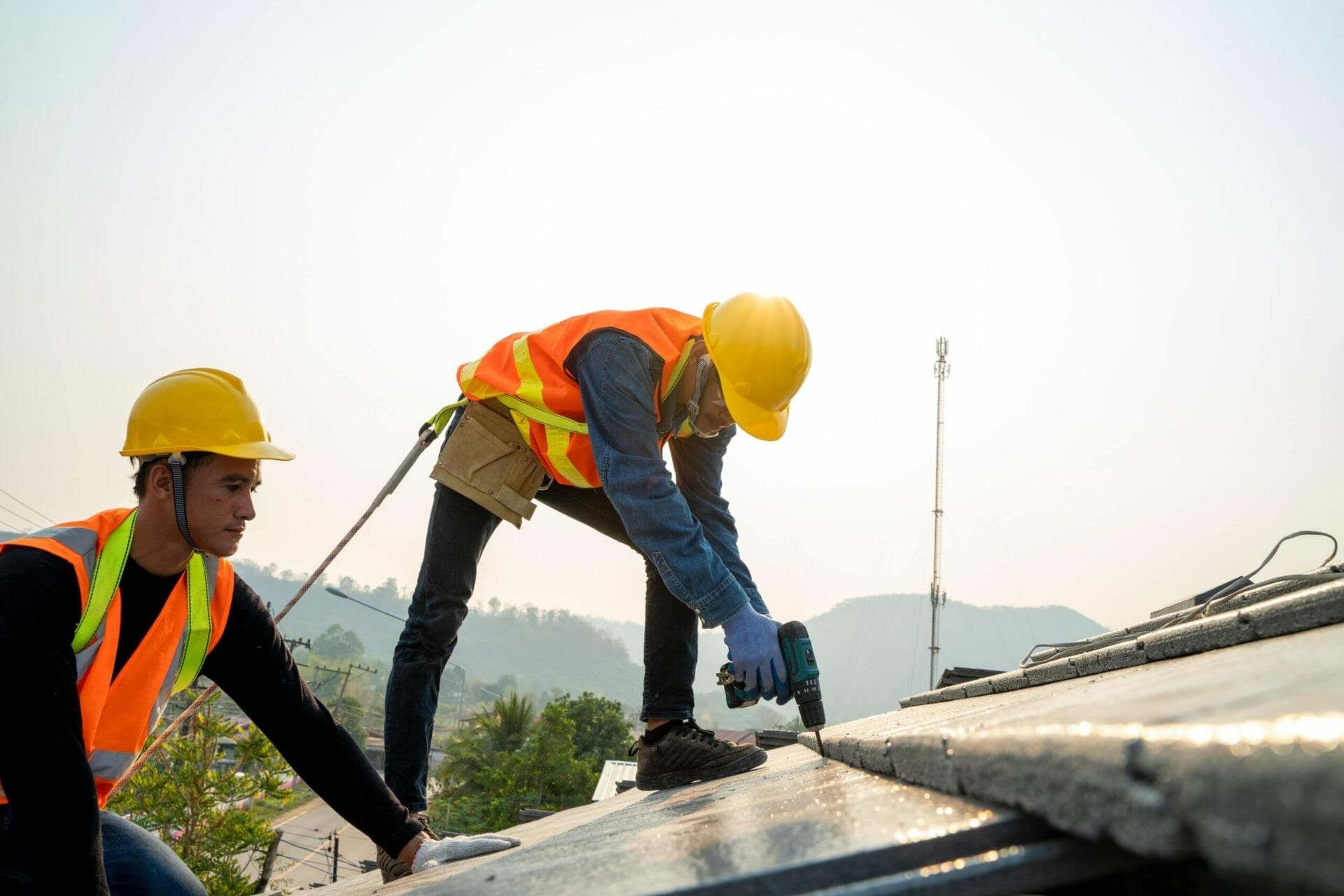Every business owner believes they’re prepared until it occurs. That’s right. It’s commercial roof repairs. If you notice leaks or feel that your roof isn’t functioning in the way it should, then you start thinking about how costly repairs will be and the time it will take to finish. Knowing the steps for commercial roof repairs can make a huge difference in cost and effort, particularly in the case of issues in the summer or winter.
Commercial buildings usually suffer damage due to weather conditions, which include things such as exposure to sunlight. The constant sun and heat could result in premature aging, and storms with strong winds can cause curving or pooled water as well as ruptured membranes. The building is then vulnerable, and this is the time to repair more urgently than you ever have.
To assist you in getting the necessary roof repairs done swiftly and effectively, we’ve provided a step-by-step guide for you to follow. Continue reading to learn more about commercial roof repairs.
How to Steps of Commercial Roof Repair
If a problem is first spotted in the form of blow-offs, flooding, flashing that is not working, or punctures in the membrane, you have to evaluate the situation and decide on what you should do next. Most repairs will be easy; however, if you have difficulty diagnosing the issue or require assistance with the problem, then you should consider hiring an expert commercial roofing company to help in the roof repair.
If you don’t, you could consider that you’re equipped with the knowledge and equipment to complete the roof repairs yourself.
Locating Contractors
If you determine that the issue is in need of fixing, and you require the services of a professional, then start by finding one that is suitable for you. Knowing what you should look for when choosing a professional or firm will assist you in selecting the ideal person or company. Here are some guidelines to assist you in making the right decision:
1. Comparing Contractors
The first step is to conduct a background study and make a list of trustworthy contractors near you. Check out their websites, find out more about them through social media sites, read reviews and testimonials of their customers, as well as look at before and after images from their work (if there are any), and confirm whether they’re accredited and licensed.
For this, check out badthe ges on the internet page or in the description of the company’s Better Business Bureau rating and association in NRCA. National Roofing Contractors Association (NRCA).
2. Ask the Right Questions
After you have done your research, you must interview the company or the person to learn what they have to offer. At this point, you’ll be asking for estimates for any commercial roof repair you require and comparing the figures and answers of every candidate. The clarity will allow you to make an informed choice.
Here are a few questions to ask
- Are you covered by general liability or workers’ compensation insurance?
- How do you get rid of the debris and other waste?
- Do you (or your team) check the roof before the start of the work?
- How do I pay? What options for payment are offered?
- How many years have you been in your business? Do you have any references?
- What types and materials will you make use of?
3. Choose Professional Contractors
While some companies offer satisfactory responses to the above questions, you should consider some additional factors. A good roofer will be able to leave you feeling comfortable in hiring them, not anxious or nervous. A roofer you can count on will always display the following traits:
- Holds a proper license
- A commitment to high-quality work
- Ethics-based business practices
- Technical proficiency
- Highly trained and has many years of experience
- Reliability
- Punctuality
- Security is the top priority.
Receiving Estimates
If you want to get an estimate of the roof repair, it is important to be sure to ask the right questions and give the correct information. This will not only aid the contractor in coming up with estimates for the cost of materials and labor, but is also the only way to receive an accurate estimate, for budgeting accordingly.
Here are some helpful tips to help you make more accurate estimations:
1. Provide Specific Information About Your Building
There are some things you should provide to the contractor. It is important to provide as many details about your business as possible. Are you operating from the premises? What industry do you operate in? Are there any hazardous materials in the vicinity? Have you got tenants? Are you combining residential and commercial? The contractor should know these details so that they are able to follow the code and take safety measures into account.
Also, you should discuss accessibility for buildings. Discuss with the contractor the dimensions, shape, and number of entrances or exits the property is located in. This will allow the contractor to estimate the number of trucks they might require and the best way to move materials and equipment into or out.
Also, be sure to disclose all the problems that the current roof has, even if you consider them minor.
2. Be aware of your quotes
When the roofing contractor has your contact information, the roofer will then do calculations and crunch numbers. Make sure you look for the following information in the estimate you receive:
- The timeline of the project discusses the project’s expectations and timeframes
- Dates for payment and cancellation policies determine the date for payment installments, as well as other rules regarding the payment and the cancellation of a project.t
- The responsibilities on behalf of the contractor (s). The article discusses the roles and responsibilities of the technicians and employees who are on the job to ensure smoother communication, as well as quicker job completion
- Materials and prices of the products. This is used for budgeting as well as quality control. The more you are aware of the items you require more straightforward it is to determine the final cost.
Be aware that good, professional contractors will provide this information in their estimates. If this information is missing, be wary.
3. Warning Signals
As stated above as previously mentioned, it is essential to be attentive when looking over the specifics of the quote. Incomplete information can pose a risk. The estimates should contain all the details listed in the preceding section, in addition to any details regarding warranty, labor, and the method of payment, and when.
Examine the warranties since some contractors may offer warranties for services that do not last for as long as the product, or other clauses that could alter what the company’s service is worth.
Repair Options
In light of the issue with your commercial roof, you’ll need to think about the kind of repair or maintenance that is required. Do you remove the entire roof and begin fresh? Do you fix the roof with patches? It’s a dilemma that many business and property owners have to deal with throughout the year. It is also important to be thinking about leasing tenants for your building if you’re a landlord.
A few tenant-friendly options for roof repairs include putting a roof coating system on the roof. Roof coatings are sprayed onto existing roofing. The application in liquid mformeameanshere is no need to fret about tearing off. Self-adhering membranes also have minimal or no odors. This keeps the air fresh and keeps workers protected.
Another option is the asphalt Emulsion. The components required include clay, asphalt, and water. The mix is free of toxic chemicals, produces no emissions, and is a durable and long-lasting choice that will safeguard your commercial roofing for a long time.
Make sure you talk about these possibilities with your roofing contractor prior to tackling repairs.
Roof Repair Know-How
If you realize there are two major choices–hiring a contractor or performing the work yourself (DIY)–you could decide to choose the second option. It is important to note that you only tackle repairs yourself if you are dealing with a minor issue. If not, it is best to engage a professional contractor or a tech to fix even the most difficult of issues.
It is also important to learn about the various roofing membranes that are suitable to be used for commercial roof repair. There are conventional materials such as bitumen, Mastic asphalt, and mixtures of tar and gravel. There are, however, metal membranes that are made of copper, aluminum, and steel.
Modern developments also include synthetic varieties, such as thermoplastic Olefin (TPO), as well as PVC plastic, rubber, and glass-reinforced polymer (GRP). Each of these membranes has distinct strengths and weaknesses; therefore, it is important to conduct your own research.
When Should You Perform Commercial Roof Repairs for Commercial Roofs
The roof is a crucial element of the structure. With no roofing repair, everything within the building will be exposed to the elements and may be damaged. If you perform regular checks and repairs, you’ll be able to prolong the life of your roof Repairs and also keep personnel and equipment secure.
Here are a few common commercial roofing problems that can result in minor repairs and temporary fixes:
- Leaking and other indicators of water damage
- The pooling of water on flat roofs
- Ageing of the roof
- Bubbles and moisture in the membrane
- Cracked, curled, or missing shingles
- The collection of detritus
If you observe any of these symptoms and you are unsure, don’t ignore these signs. This could result in larger, more costly issues in the future.
Tips for Do-it-yourself Commercial Roof Repair
Simple roof repairs don’t always require a skilled roofer to carry out. If you have the tools to tackle the task and complete the task, then you are able. It is essential to have the right materials, including safety equipment (glasses and gloves, boots and hard hats) as well as flat roof repair materials that fit the present membrane and roofing nails, and other such things. Then, must follow the steps below.
- Examine: Go up on the roof and look for areas of concern, such as broken shingles, warping or sinking, or pools of stagnant water.
- Clean up the area: Make certain to eliminate any pooled or accumulated particles that you discover. This could reveal more issues. Make sure you dispose of all water and other items in a proper manner.
- To remove blisters: if you notice blisters, it is necessary to cut them open to release the air or water. Don’t cut through the roof felt. Lift the loose piece and cut it.
- Get rid of water: Once more, search for the water or moisture, then absorb it with rags. Make sure the affected areas are completely dry before you begin repairs. Any moisture that remains trapped can become an issue in the future.
- Utilize roofing: cement in order to protect damaged areas. Spread the coating in a thick enough layer so that you cover up the damaged area and extend it into the unaffected areas. Scrape it smooth and then apply another coating if required. Repeat the procedure to fill any cracks or holes you see.
- Roof membranes: The final step is to install the new membrane. Take measurements of the material and cut it into the desired size. As the cement is in its setting state, you can place the roofing membrane over the surface. The membrane should cover the entire surface. Smooth it to eliminate any air and then apply the membrane with galvanized nails. It is also possible to seal the areas that are damaged with a second aluminum coating or apply the aluminum coating over everything on your roof. The coating will stop powerful UV rays, increase the lifespan of the roof repair.
Conclusion
Repair and replacement of commercial roofs can be expensive and take an extended time to complete; however, it’s an investment that is necessary to make.
This is why it is important to be aware of the requirements for roofing repair and how to identify a professional contractor who can ease the cost. Do not allow the issue to get worse, since it will adversely affect your commercial or business property and all those who are involved.
There isn’t a universal solution for commercial roof repair. Each client is unique. If you’re still unsure regarding commercial roof repairs or require an inspection or estimation, do not hesitate to contact us. Complete the contact form and we’ll be in contact!




